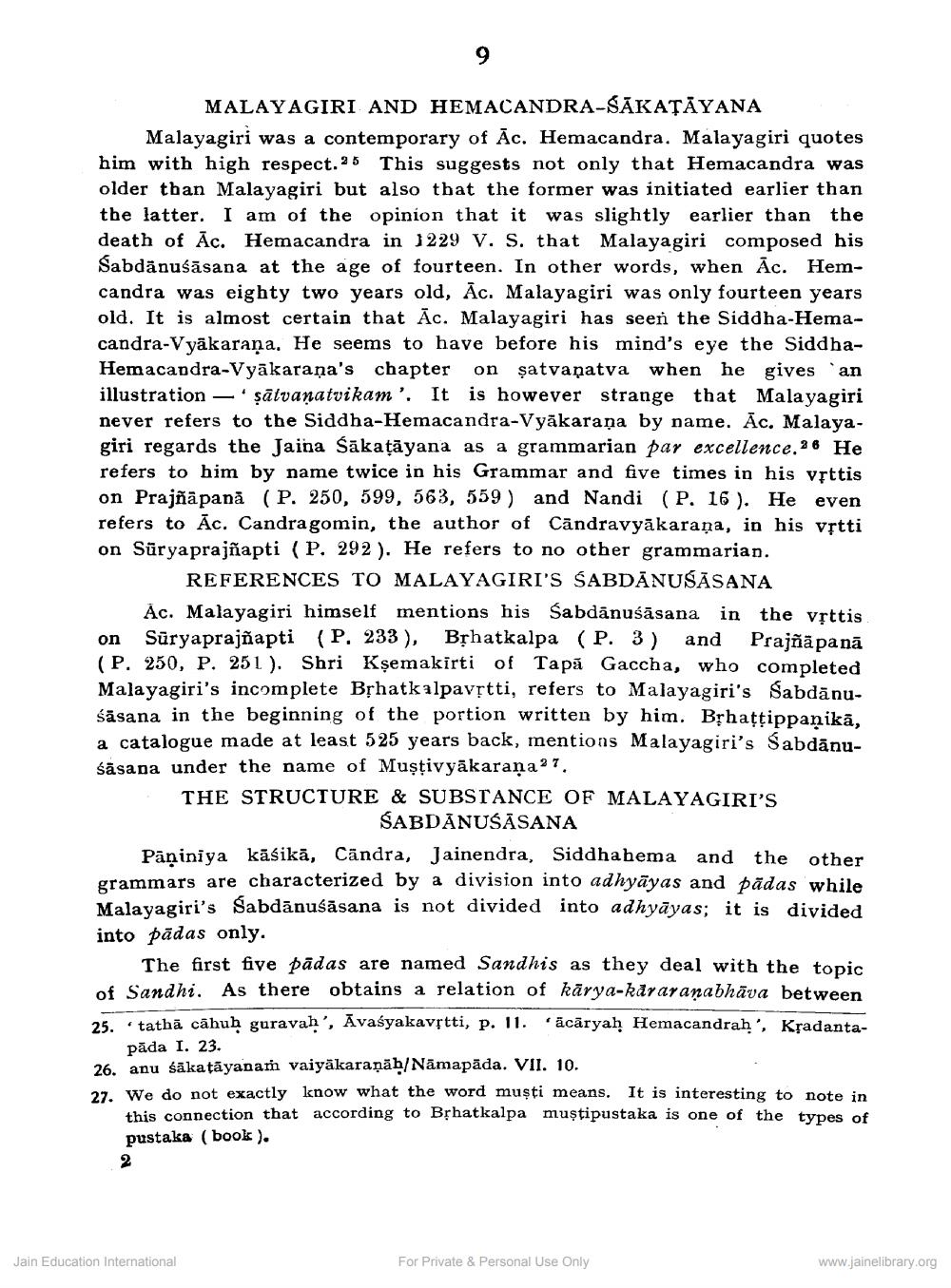________________
ANA
MALAYAGIRI AND HEMACANDRA-SĀKAȚĀYANA Malayagiri was a contemporary of Āc. Hemacandra. Malayagiri quotes him with high respect.25 This suggests not only that Hemacandra was older than Malayagiri but also that the former was initiated earlier than the latter. I am of the opinion that it was slightly earlier than the death of Āc. Hemacandra in 1229 V. S. that Malayagiri composed his Sabdanuśāsana at the age of fourteen. In other words, when Āc. Hemcandra was eighty two years old, Ac. Malayagiri was only fourteen years old. It is almost certain that ac. Malayagiri has seen the Siddha-Hemacandra-Vyākaraṇa. He seems to have before his mind's eye the SiddhaHemacapdra-Vyākarana's chapter on şatvaṇatva when he gives an illustration — sālvanatvikam'. It is however strange that Malayagiri never refers to the Siddha-Hemacandra-Vyakarana by name. Ac. Malayagiri regards the Jaina Śākațāyana as a grammarian par excellence. 26 He refers to him by name twice in his Grammar and five times in his vsttis on Prajñāpanā (P. 250, 599, 563, 559) and Nandi (P. 16). He even refers to Ac. Candragomin, the author of Cāndravyākaraṇa, in his vịtti on Süryaprajñapti (P. 292). He refers to no other grammarian.
REFERENCES TO MALAYAGIRI'S SABDĀNUŠĀSANA Ac. Malayagiri himself mentions his Sabdānuśāsana in the vrttis on Süryaprajñapti (P. 233 ), Bphatkalpa (P. 3) and Prajñāpanā (P. 250, P. 251 ). Shri Ksemakirti of Tapă Gaccha, who completed Malayagiri's incomplete Bșhatkalpavștti, refers to Malayagiri's SabdānuŚäsana in the beginning of the portion written by him. Bșhattippanikā, a catalogue made at least 525 years back, mentions Malayagiri's Sabdanu. śāsana under the name of Muștivyākarana??. THE STRUCTURE & SUBSTANCE OF MALAYAGIRI'S
SABDANUŠĀSANA Paniniya kāśikā, Candra, Jainendra, Siddhahema and the other grammars are characterized by a division into adhyāyas and pādas while Malayagiri's Sabdānušāsana is not divided into adhyāyas; it is divided into pādas only.
The first five pādas are named Sandhis as they deal with the topic of Sandhi. As there obtains a relation of karya-kararanabhāva between 25. tathā cāhuh guravah', Avaśyakavrtti, p. 11. ācāryah Hemacandrah', Kradanta
pāda I. 23. 26. anu sākatāyanam vaiyakaraņāb/Nämapäda. VII. 10.
We do not exactly know what the word musti means. It is interesting to note in this connection that according to Bșhatkalpa mustipustaka is one of the types of pustaka (book ).
Jain Education International
For Private & Personal Use Only
www.jainelibrary.org




